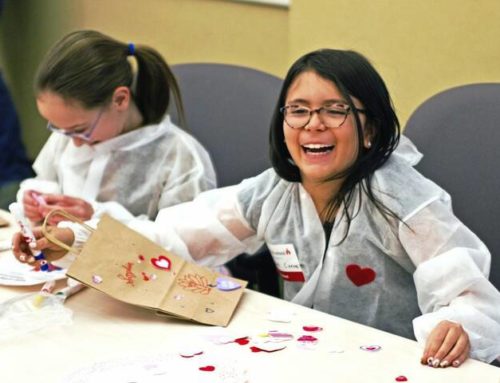As seen in CNN, people and Forbes
Little Medical School was recently featured on cnn.com! Check out the article below, or view the original article here.
(CNN) Consider it the Challenge of 2020: It’s likely easier to put lipstick on a ferret than it is to get some kids to wear face coverings.
The little humans pull and tug at the masks constantly. Kids don’t just stop there. They let the tops fall beneath their noses and sometimes even yank the things down below their mouths, just because they can.
Despite all these protests from children in countries where face coverings are new to them, masks are a must.
In the United States, the US Centers for Disease Control and Prevention recommends that all kids over the age of 2 wear face coverings to help reduce the spread of Covid-19.
That means that now is the time to finally get kids on board — if you haven’t already — with the new reality. We know kids around the world who already know how to wear masks — it’s simply part of their routine when they leave the house.
How do you get your child there? We’ve asked doctors, psychologists and parents for their best strategies for getting little ones to wear face coverings and keep them on. Here are their top five suggestions.
Know your child
Every child is different, which means it behooves parents to take the time to think about how each of their children may relate to face coverings.
“It’s not a one-size-fits-all kind of thing,” said Jennifer Sciolla, senior director of child and family services at Nemours Alfred I. duPont Hospital for Children in Wilmington, Delaware. “You always want to make that time and space in the beginning for parents to consider their child.”
Parents should ask themselves a series of questions before even trying to formulate a strategy to get kids to wear face coverings, Sciolla suggested.
Among them: What is important to my child? How does my child understand information? How aware of the outside world is my child? To what extent might a mask or the possibility of a mask give my child anxiety?
Part of the issue is age. Toddlers may be frightened to see others in masks because they lack the ability to recognize and read faces that kids develop by adolescence, research has indicated.
Another factor: a child’s developmental needs.
Stephanie Ranno, whose 7-year-old daughter Emmy is on the autism spectrum, said her daughter struggles to wear face coverings for any extended period. Ranno, who lives outside of Baltimore, added that it’s hard to know why her daughter dislikes the masks because she has expressive language delay, which means she can’t always communicate adequately.
“Emmy is learning to interpret facial expressions for appropriate social interactions and masks make it nearly impossible for that to happen,” Ranno wrote in a text message. “Our main concerns in sending her back to school center on difficulty in her ability to safely and positively interact with teachers and classmates.”
Explain what’s up
Parents and guardians can’t simply expect little ones to understand why they should wear face coverings — moms and dads must explain it with words and concepts the kids can understand.
For preschool-age children, this might mean offering a Sesame Street version of pandemic etiquette: The virus is a bad guy, and we humans must do what we can to protect our lungs and bodies from it. For others, especially older kids, it might mean a more detailed and sophisticated rundown of public health and our individual responsibility to a greater good.
Parents can emphasize kindness to get kids to understand that wearing face coverings isn’t only about them, recommended Liza Suarez, assistant professor of clinical psychiatry at the University of Illinois at Chicago.
“It’s helpful to say things like, ‘Face coverings reduce the chances we infect others,’ and, ‘If we all wear masks, we protect each other,'” said Suarez, director of the university’s Pediatric Stress and Anxiety Disorders Clinic. “You can’t really go wrong if you teach your child that we’re all part of this world, and we need to help each other out.”
Maki Katsuki, a mother of three, agreed.
Katsuki moved to Sonoma County, California, from Niseko, Japan, in 2017, and remembers what she learned about face coverings as child growing up in Asia.
“Everyone was taught wearing a mask when you are sick is key because you don’t want to spread germs to other people,” she said.
Katsuki added that she repeatedly has required her children to wear face coverings over the years, saying, “We also wear masks to prevent (from getting) sick when others are sick.”
Engage and involve your children
Another way to get kids excited about face coverings is to make them part of the process. This can be as simple as letting kids select their own masks or as complicated as inviting kids to sit down at the sewing machine.
For Melissa CousinoHood, the wonder was in letting her 3-year-old pick out a face covering. The girl loves purple and jumped at the chance to choose a mask that was her favorite color. In general, kids also appreciate getting to have a say in style of the masks they wear, Cousino Hood added.
“You’d let them pick out a T-shirt,” said Cousino Hood, assistant professor of pediatrics at the University of Michigan’s Center for Human Growth & Development. “Why wouldn’t you let them pick out a face covering?”
Courtney Fitzgerald, who lives in Shawnee, Kansas, has taken the commitment to engagement one step further, getting her three children (ages 3, 5 and 10) to help make masks.
Fitzgerald said she has made about two dozen masks since the pandemic began — including some with rainbow tie-dye, floral-patterned fabric, one with the Kansas City Chiefs logo and a throwback print with dinosaurs and trolls.
Specifically, she said the kids have helped cut out the fabric and make the folds in the masks themselves.
“It reminds me of the advice from the professionals on how to get your kids to eat new foods — you involve them in the process,” said Fitzgerald, who admitted to raiding her mother’s fabric stash for some of the harder-to-find patterns. “I (often) find them digging through the fabric pile and picking out the next one they want me to make.”
Practice, practice, practice
Once parents have sold kids on the idea of wearing face coverings, it’s critical for parents to get them to embrace it. At the very minimum, this means getting children to wear the masks — and getting them to wear the masks the right way.
Parents can try having kids wear their masks in the house for short increments to feel more comfortable, Suarez, the psychiatrist, said. Cousino Hood added that another fun activity is to have kids don masks and look at themselves in the mirror to get familiar with the different permutations of “smizing,” or smiling with your eyes. (She called this “medical play.”)
Parents could also consider turning mask-wearing into a game, suggested Gail Robertson, a child psychologist at Children’s Mercy Hospital in Kansas City, Missouri.
“Because we have this association in our culture with (public health) being scary — having (face coverings) as a part of play is essential,” said Robertson, assistant professor of pediatrics at the University of Missouri-Kansas City School of Medicine.
“Make it for a doll. I also love having masks in the playroom and their bedroom so (kids) can play with them and investigate them. We want to make masks a part of their normal environment.”
Dr. Mary Mason, an internist based in St. Louis, believes in this approach, too.
In 1999, Mason founded Little Medical School, a science and technology course provider.
Earlier this year, her company rolled out Face Covering Kits that comprise two cloth face coverings, a 6-foot tape measure, and a sheet of stickers that read BACK UP 6 FEET, I’M SOCIAL DISTANCING, MY GOOD HABIT IS WASHING MY HANDS and more.
“We don’t want kids to think they need a real surgeon’s mask, but we do want to make sure they understand the science,” Mason said. “When you give kids facts and the science behind them, you empower them to seek the truth.”
Communicate repeatedly
Especially with younger kids, repetition is a key to ensuring compliance with new rules. This means that as much as you don’t want to nag, you may have to sound like a broken record in order for your children to take face coverings seriously and understand the gravity of the situation in the midst of a global pandemic.
The name of the game is consistency, Suarez said, noting that parents must relentlessly remind children of this rule: They simply cannot move around in the world right now without wearing a mask to protect themselves and others.
“It’s like anything with parenting, really; this isn’t going to happen overnight,” she said. “Instead, parents need to accept that they’re laying a foundation that requires gradual increments of time. Little by little, parents get the message across.”
Lenneia Elmore, who lives in Orlando, Florida, understands this challenge fundamentally.
Elmore recently joked that she has been so on-message lately, she practically has developed a mask-oriented mantra for her 2.5-year-old daughter, Ava.
“Whenever we go anywhere, I keep telling her, ‘Don’t take off your mask, only play with Mommy,'” said Elmore, whose family has a history of medical conditions. “I started saying it to her back in April, and now she repeats it back to me. She used to think I was ‘mean’ when I asked her to wear one. Now she gets it. She wears it without giving me an attitude. It’s like it finally sunk in. Thank goodness.”







Leave A Comment
You must be logged in to post a comment.